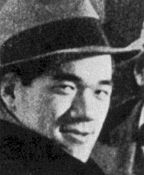Sadao Yamanaka
| Sadao Yamanaka | |
|---|---|
 |
|
| Born |
November 7, 1909 Kyoto City, Kyoto, Japan |
| Died | September 17, 1938 (aged 28) Manchuria, China |
| Other names | Kimpachi Kajiwara |
| Occupation | Film director, screenwriter |
| Years active | 1932-1938 |
| Organization | Narutaki-gumi |
Sadao Yamanaka (山中 貞雄 Yamanaka Sadao?, November 7, 1909 – September 17, 1938) was a Japanese film director and screenwriter who directed 26 films between 1932 and 1938. He was a contemporary of Yasujirō Ozu, Mikio Naruse and Kenji Mizoguchi and one of the primary figures in the development of the jidaigeki, or historical film. Yamanaka died of dysentery in Manchuria after being drafted into the Imperial Japanese Army. He is the uncle of the Japanese film director Tai Kato, whowrote a book about Yamanaka, Eiga kantoku Yamanaka Sadao.
Only three of his films survive in nearly complete form. While long considered a master filmmaker in his native Japan, interest in Yamanaka's work redeveloped after the restoration and Japanese DVD release of the three surviving films. His most internationally discussed film, Humanity and Paper Balloons (1937), was given its first non-Japanese DVD release in the UK as a Masters of Cinema release.
Yamanaka began his career in the Japanese film industry at the age of 20 as a writer and assistant director for the Makino company.
In 1932, he began working for Kanjuro Productions, a small, independent film company similar to many others founded during the same period as it was centered around a popular jidaigeki film star, this time Kanjuro Arashi. Here, he began directing his first films, all of which were jidaigeki. During his first year at Kanjuro, he made six films. He was "discovered" by the critic Matsuo Kishi and gained a reputation for creating films that escaped clichés and focused on social injustices. He formed the Narutaki-gumi with his friends, and they wrote under the pseudonym Kimpachi Kajiwara.
...
Wikipedia
